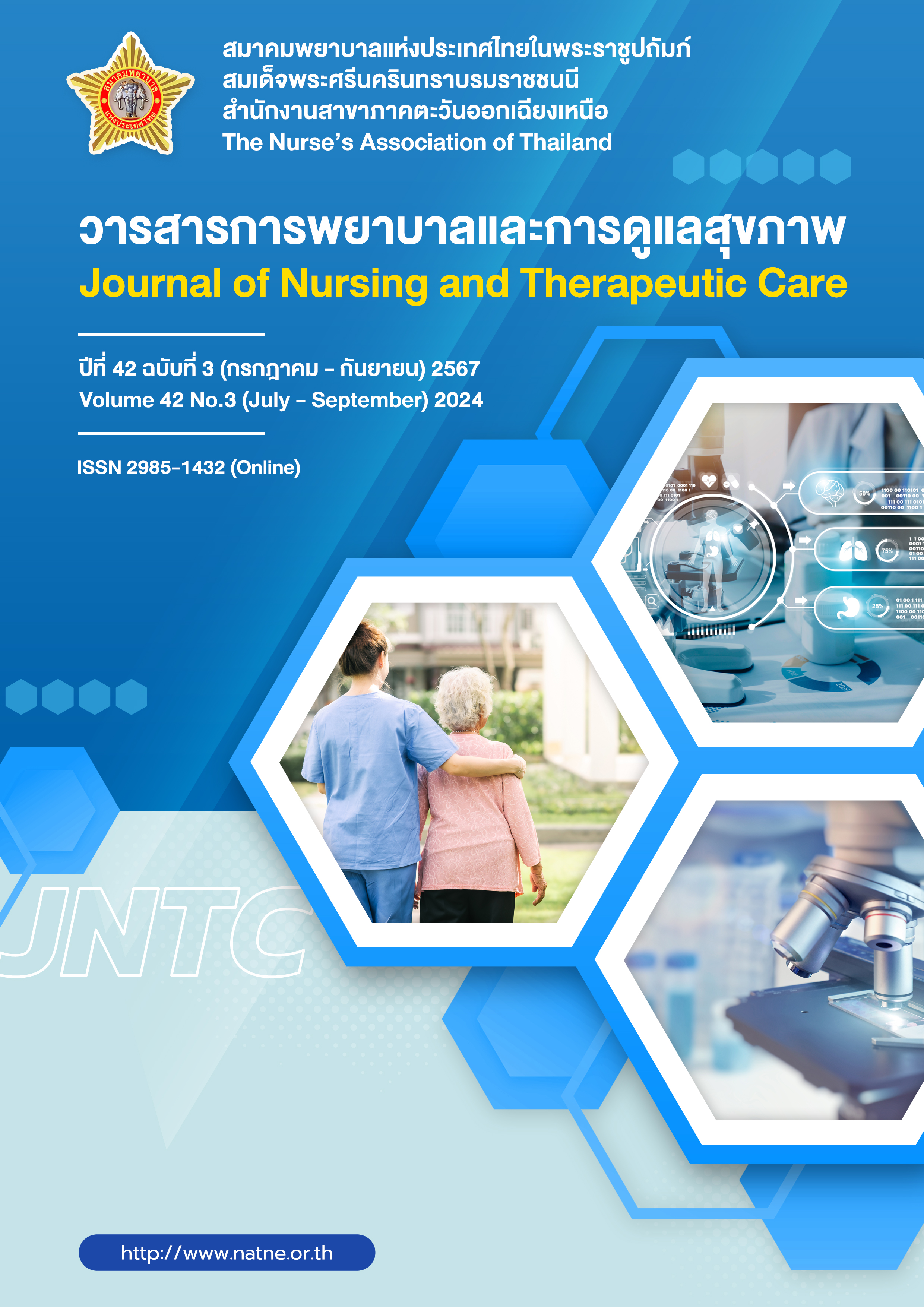ปัจจัยที่ส่งผลกระทบต่อการจัดการภาวะฟอสเฟตในเลือดสูง ของผู้ป่วยรอปลูกถ่ายไต: กรณีศึกษาผู้ป่วย 2 ราย
คำสำคัญ:
ภาวะฟอสเฟตในเลือดสูง, ปัจจัย, การจัดการ, การปลูกถ่ายไต, โรคไตเรื้อรังบทคัดย่อ
ภาวะฟอสเฟตในเลือดสูงส่งผลต่อภาวะแปรปรวนของดุลเกลือแร่และกระดูกที่เกิดจากโรคไตเรื้อรัง ทำให้เกิดความผิดปกติของเกลือแร่และฮอร์โมน เช่น ภาวะพาราไทรอยด์สูงทุติยภูมิ ความผิดปกติของกระดูก และการสะสมตะกอนแคลเซียมในหลอดเลือด มีผลต่อโรคหลอดเลือดหัวใจ และเพิ่มอัตราการเสียชีวิต ผู้ป่วยส่วนใหญ่ไม่มีอาการแสดงใด ๆ จนกระทั่งโรคดำเนินไปจนแก้ไขได้ยากเป็นภัยเงียบที่อันตรายอย่างยิ่งในกลุ่มผู้ป่วยรอปลูกถ่ายไต ถ้าระดับฟอสเฟตในเลือดสูงต่อเนื่องจะส่งผลต่อภาวะแทรกซ้อนระยะยาวรุนแรงทำให้ผู้ป่วยถูกระงับการผ่าตัดปลูกถ่ายไตได้ จนกว่าภาวะฟอสเฟตในเลือดสูงจะได้รับการแก้ไข
การควบคุมฟอสเฟตในเลือดให้ได้ตามเกณฑ์เป้าหมายจึงมีความสำคัญ ซึ่งการแก้ปัญหาดังกล่าวทีมสุขภาพต้องมีความเข้าใจสาเหตุที่แท้จริงที่ส่งผลต่อการควบคุมฟอสเฟตในเลือดของผู้ป่วย บทความนี้มีวัตถุประสงค์เพื่อศึกษาปัจจัยที่ส่งผลต่อการจัดการภาวะฟอสเฟตในเลือดสูงในผู้ป่วยรอปลูกถ่ายไต โดยการทบทวนหลักฐานเชิงประจักษ์จำนวน 17 เรื่อง โดยใช้ PICO Framework และประเมินคุณภาพโดยใช้เกณฑ์ของ The Joanna Briggs Institute Level of Evidence ผลการทบทวนหลักฐานเชิงประจักษ์พบว่ามีปัจจัยหลัก 3 กลุ่มได้แก่ 1) ปัจจัยด้านผู้ป่วย 2) ปัจจัยด้านการรักษา และ 3) ปัจจัยด้านระบบสุขภาพ ซึ่งแต่ละปัจจัยมีทั้งปัจจัยทางบวกและปัจจัยทางลบ นอกจากนี้ยังนำเสนอการวิเคราะห์เปรียบเทียบกรณีศึกษาผู้ป่วยรอปลูกถ่ายไต 2 ราย เพื่อช่วยให้เกิดความเข้าใจปัจจัยที่ส่งผลต่อการจัดการภาวะฟอสเฟตในเลือดสูงที่เกิดในบุคคลจากสถานการณ์จริง ความรู้ที่ได้นำไปสู่การออกแบบการดูแลผู้ป่วยที่มีปัญหาดังกล่าวได้อย่างมีประสิทธิภาพและสอดรับกับสาเหตุจริง
Downloads
เอกสารอ้างอิง
Wu Y, Lv K, Hao X, Lv C, Lai W, Xia X, et al. Waiting-List and early posttransplant prognosis among ethnoracial groups: data from the organ procurement and transplantation network. Front Surg. 2023;10:1045363.
Wichaisak W, Lueboonthavatchai P, Avihingsanon Y. Comparative study of quality of life between end- stage renal disease patients treated with dialysis and those treated with kidney transplantation at King Chulalongkorn Memorial Hospital. Chulalongkorn Medical Journal. 2018;62(1):91–105. (in Thai)
Kidney Disease: Improving Global Outcomes (KDIGO) CKD-MBD Update Work Group. KDIGO 2017 Clinical Practice Guideline Update for the Diagnosis, Evaluation, Prevention, and Treatment of Chronic Kidney Disease-Mineral and Bone Disorder (CKD-MBD). Kidney Int Suppl. 2017;7:1–59.
Anand A, Aoyagi H. Understudied hyperphosphatemia (Chronic kidney disease) treatment targets and new biological approaches. Medicina. 2023;59(5):959.
Kiatsunthorn K. CKD-MBD. Academic Conference CKD Weekened 2021 Living with Kidney in Disruptive Era. 2021 November 12-14; Virtual Online Meeting. Association of Kidney Diseases. (in Thai)
Tsai MH, Chen M, Liou HH, Lee TS, Huang YC, Liu PY, et al. Impact of pre-transplant parathyroidectomy on graft survival: a comparative study of renal transplant patients (2005-2015). Med Sci Monit. 2023;29:e940959.
Doshi SM, Wish JB. Past, present, and future of phosphate management. Kidney Int Rep. 2022 ;7(4):688–98.
Vogt I, Haffner D, Leifheit-Nestler M. FGF23 and phosphate–cardiovascular toxins in CKD. Toxins (Basel). 2019;11(11):647.
Disthabanchong S. Hemodialysis renal replacement therapy. 1st ed. Bangkok: Faculty of Medicine, Chulalongkorn University; 2013. (in Thai)
Sprague SM, Martin KJ, Coyne DW. Phosphate balance and CKD–mineral bone disease. Kidney Int Rep. 2021;6(8):2049–58.
Rastogi A, Bhatt N, Rossetti S, Beto J. Management of hyperphosphatemia in end-stage renal disease: a new paradigm. J Ren Nutr. 2021;31(1):21–34.
Jung J, Jeon-Slaughter H, Nguyen H, Patel J, Sambandam KK, Shastri S, et al. Hyperphosphatemia and its relationship with blood pressure, vasoconstriction, and endothelial cell dysfunction in hypertensive hemodialysis patients. BMC Nephrol. 2022;23(1):291.
Block GA, Kilpatrick RD, Lowe KA, Wang W, Danese MD. CKD–mineral and bone disorder and risk of death and cardiovascular hospitalization in patients on hemodialysis. Clin J Am Soc Nephrol. 2013;8:2132–40.
Chan MW, Cheah HM, Mohd Padzil MB. Multidisciplinary education approach to optimize phosphate control among hemodialysis patients. Int J Clin Pharm. 2019;41(5):1282–9.
Society of parenteral and enteral nutrition of Thailand. Clinical practice recommendation for nutritional management in adult kidney patients 2018 [Internet]. 2018 [cited 2023 Feb 20]. Available from: https://rb.gy/qio61i
Milazi M, Douglas C, Bonner A. A bundled phosphate control intervention (4Ds) for adults with end-stage kidney disease receiving haemodialysis: A cluster randomized controlled trial. J Adv Nurs. 2021;77(3):1345–56.
Cupisti A, Gallieni M, Rizzo MA, Caria S, Meola M, Bolasco P. Phosphate control in dialysis. Int J Nephrol Renovasc Dis. 2013;6:193–205.
Tabibi MA, Wilund KR, Salimian N, Nikbakht S, Soleymany M, Roshanaeian Z, et al. The effect of intradialytic exercise on calcium, phosphorus and parathyroid hormone: a randomized controlled trial. BMC Nephrol. 2023;24(1):276.
Suttisakphakdee S, Puwarawuttipanit W, Saneha C. Factors predicting abnormal calcium and phosphate product in hemodialysis patients. Nursing Science Journal of Thailand. 2017;35(3):36–45. (in Thai)
Umeukeje EM, Mixon AS, Cavanaugh KL. Phosphate-control adherence in hemodialysis patients: current perspectives. Dove Med Press. 2018;12:1175–91.
Guo H, Sriyuktasuth A, Pongthavornkamol K. Factors associated with phosphate binder adherence among patients undergoing hemodialysis in China. Nursing Science Journal of Thailand. 2022 ;40(4):123–37. (in Thai)
Ng ESY, Wong PY, Kamaruddin ATH, Lim CTS, Chan YM. Poor sleep quality, depression and social support are determinants of serum phosphate level among hemodialysis patients in Malaysia. Int J Environ Res Public Health. 2020;17(14):5144.
Alzahrani AMA, Al-Khattabi GH. Factors affecting adherence to phosphate-binding medications among patients with end-stage kidney disease in Makkah City. Saudi J Kidney Dis Transpl. 2022;33(4):516-525.
Somuah LA. Educating primary care nurses on phosphorus management in chronic kidney disease patients [Internet] [D.N.P.]. ProQuest Dissertations and Theses. [United States Minnesota]: Walden University; 2018 [cited 2024 Mar 2]. Available from: https://rb.gy/ybcv8u
Khaosumain U, Thongmee P, Phewruangnon R, Srisuwarn P, Tiansaard J. The effects of self-efficacy promoting “3D” program on phosphate control behaviors and serum phosphate level in patients receiving hemodialysis: A feasibility study. Health Science Journal of Thailand. 2022;4(2):1–12. (in Thai)
Pinthong S. Patients with chronic kidney disease undergoing hemodialysis: the effectiveness of a self-management education program on self-care behaviors in controlling hyperphosphatemia hemodialysis unit, Songkhla hospital. Journal of Nursing and Education. 2023;16(1):32–47. (in Thai)
Chamnan A, Kitsripisarn S, Tasanarong A. Impact of individual and family self-management programme on hemodialysis-treated patients’ adherence to phosphorus control and on their calcium x phosphorus product. The Journal of Thailand Nursing and Midwifery Council. 2021;36(2):49–65. (in Thai)
Organ Donation Center, Thai Red Cross Society. Annual report [Internet]. 2022 [cited 2024 Feb 25]. Available from: https://www.organdonate.in.th/assets/files/odc2565.pdf . (in Thai)
The Nephrology Society of Thailand. Thailand renal replacement therapy: year 2020 [Internet]. 2020. [cited 2024 Feb 25]. Available from: https://www.nephrothai.org/wp-content/uploads/2022/06/Final-TRT-report-2020.pdf. (in Thai)
Joanna Briggs Institute. Supporting Document for the Joanna Briggs Institute Levels of Evidence and Grades of Recommendation [Internet]. 2014 [cited 2023 Sep 25]. Available from: https://jbi.global/sites/default/files/2019-05/JBI%20Levels%20of%20Evidence%20Supporting%20Documents-v2.pdf. (in Thai)
ดาวน์โหลด
เผยแพร่แล้ว
รูปแบบการอ้างอิง
ฉบับ
ประเภทบทความ
สัญญาอนุญาต
ลิขสิทธิ์ (c) 2024 วารสารการพยาบาลและการดูแลสุขภาพ

อนุญาตภายใต้เงื่อนไข Creative Commons Attribution-NonCommercial-NoDerivatives 4.0 International License.



